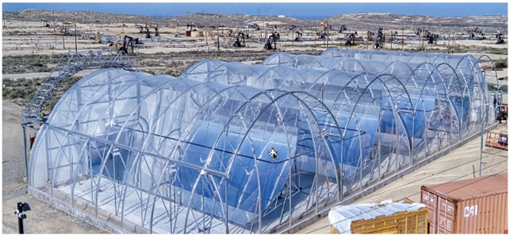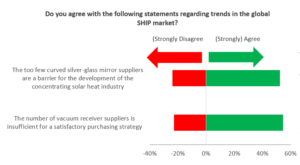USD 8 million injection into the lean structure of new Glasspoint
August 16, 2023
Glasspoint has closed its Series A funding round with USD 8 million. The US-headquartered, privately held company will use the money to increase project development activities in the field of solar industrial steam plants. According to a press release from 31 July the leading investor was 300PPM, a newly founded zero-carbon venture firm based in Berlin. CEO Rod MacGregor re-established Glasspoint in 2022 after its insolvency in 2020. He starts with a lean workforce of around 20 employees following a new business model focusing on heat supply services. The photo shows the demonstration plant of the second-generation enclosed parabolic trough design in McKittrick, California. Photo: Glasspoint
300PPM sees a USD 444 billion market potential in industrial process heat. “With a robust customer pipeline and an impressive executive team, Glasspoint is well-positioned to lead essential decarbonization efforts across industries”, said Howar Talabany, one of the founding partners of 300PPM. She has joined Glasspoint’s Board of Directors, bringing more than ten years of experience in energy transaction structuring with her. Originally from Iraq, she is well-placed to support project development in the Middle East, which is on a good track according to MacGregor. Glasspoint signed a memorandum of understanding in June 2022 to develop a 1.5 GWth solar steam plant for Ma’aden, a large aluminium producer in Saudi Arabia.
Howar Talabany (left), Founding Partner of 300PPM and former commercial executive at Shell, has joined Glasspoint´s Board of Directors. Rod MacGregor is the founder and CEO of the former and new Glasspoint. MacGregor has founded several other venture capital-backed high tech companies in his career. Photos: Glasspoint
New lean business model involving EPC suppliers
How did the contact come about with 300PPM? Henri de Bokay, Chairman of 300PPM and real estate investment specialist, was among the first angel shareholders during the restart of Glasspoint in 2022. He then founded 300PPM this year and took a larger stake in the company.
One of the main factors that differentiate Glasspoint’s current operation from its previous form is the fact that they have a very different and lean company structure. While the former Glasspoint engaged more than 300 people, who mostly worked in one location in California, the company now has less than 20 staff, located on different continents.
There is an operations and technology centre in Hampshire, United Kingdom, and a technology centre in Stuttgart, Germany, as well as a team in New York, USA, trying to sort out the many questions related to qualification for applications under the Inflation Reduction Act. “This is the new way to run global businesses,” said MacGregor in an interview with solarthermalworld.org.
He does not want to go back to having several hundred employees who design, plan and construct large solar steam plants in far way locations such as the desert in Oman. He explained: “We will be the designers behind the system and the specialist in our unique technology. But for the project implementation we will involve EPC suppliers who construct the solar steam plants according to our specification, for example Abengoa, Bechtel, TSK or SEPCOIII.” The significantly reduced payroll makes the company much more resilient if a project is postponed, a lesson that MacGregor learned from the insolvency.
Multi-source strategy to avoid supply chain constraints
And how does MacGregor imagine the new purchasing and/or manufacturing strategy for the key components of the embedded parabolic trough technology? “We will go close to the site for manufacturing of the mirrors”, confirmed the CEO. In the former Glasspoint era the company produced the key components such as mirrors and receivers partlyin a factory in China. Now, if the team wins a big contract, for example in California, they would want to build up a production site in the same area.
MacGregor is relaxed about purchasing the aluminium mirror plates, as this is a product from the lighting industry and there are many suppliers.
The CEO has more concerns about the procurement of the receivers. Here, the number of providers is limited. In Europe, only Rioglass offers evacuated receivers, with its factory in Spain, and in China there are two other companies – Himin and Huiyin – who were approved by the Purchasing Department of the former Glasspoint. “We will use a multi-source purchase strategy again for our major projects”, confirmed MacGregor. “And as a backup we have our own receiver design that we can manufacturer if required,”
New generation of enclosure structure
A third new key component of Glasspoint’s technology is emerging through the new generation of the enclosure structure. It no longer consists of a greenhouse made of glass, but of a hooped roof made of film. Glasspoint is planning to manage the manufacturing of the film in-house.
The new film-based casing structure has a number of advantages, according to MacGregor. It improves the price-performance ratio by a third compared to the greenhouses used in the big reference plant in Miraah in Oman. Of course, this also involves a reduction in the carbon footprint of the unit, because glass is very energy-intensive to manufacture. And the third advantage relates to the tightness. The outer shell now consists of far fewer parts and the risk of leaks is therefore not as great. This is important because the envelope is pressurized to keep dust and debris away from the parabolic trough collectors.
Websites of companies mentioned in this news article:
Glasspoint: https://www.glasspoint.com/
300PPM: https://www.300ppm.co/
Himin Solar: http://himinsun.com/
Huiyin Group: http://www.huiyin-group.com/eindex.aspx
Abengoa: https://www.abengoa.com/web/en/
Bechtel: https://www.bechtel.com/
TSK: https://www.grupotsk.com/en/
SEPCOIII: http://www.sepco3.com/



